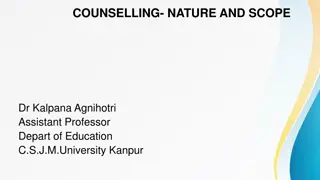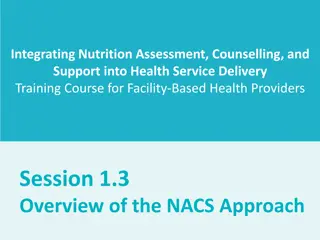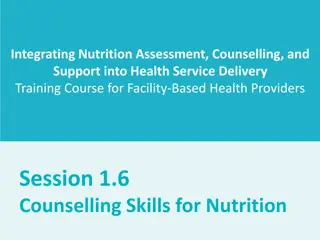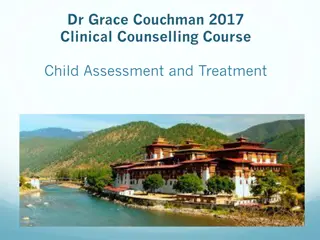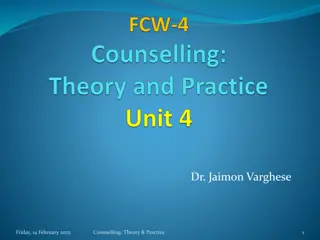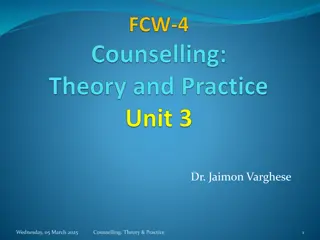
Approaches to Counselling: Directive, Non-Directive, Eclectic
Explore the directive approach to counselling, emphasizing the active role of the counsellor in providing guidance and solutions. Learn about the steps involved in directive counselling, including analysis, synthesis, diagnosis, and prognosis, as presented by Dr. Mahashevt Gaur at Brahman College of Education, Rohtak.
Download Presentation

Please find below an Image/Link to download the presentation.
The content on the website is provided AS IS for your information and personal use only. It may not be sold, licensed, or shared on other websites without obtaining consent from the author. If you encounter any issues during the download, it is possible that the publisher has removed the file from their server.
You are allowed to download the files provided on this website for personal or commercial use, subject to the condition that they are used lawfully. All files are the property of their respective owners.
The content on the website is provided AS IS for your information and personal use only. It may not be sold, licensed, or shared on other websites without obtaining consent from the author.
E N D
Presentation Transcript
GUIDANCE AND COUNSELLING UNIT-2 INTRODUCTION TO COUNSELLING TOPIC- APPROACHES TO COUNSELLING LECTURE-1 PRESENTED BY: DR. MAHASHEVTA GAUR BRAHMAN COLLEGE OF EDUCATION, ROHTAK.
APPROACHES TO COUNSELLING DIRECTIVE NON- DIRECTIVE ECLECTIC
The Directive Approach to Counselling This approach envisages a more active role for the counsellor. The counsellor employs varying degrees of direction to help the counselee to reach sound solutions. Also, through knowledge and experience in scientific diagnosis and interpretation of data, counselees are helped to reach earliersolutions fortheir problems. his own specialised
The Directive Approach to Counselling According to Frederick Thorne, the proponent of this approach, the need for direction by the counsellor is inversely proportional to the individual counselee's potentialities for self-regulation. Though the basic responsibility for reaching the solution is primarily with the counsellor as the counselling proceeds. Counselees are encouraged more and more to take up increased responsibility approach presupposes a more personalised relation with the counselee where the counsellor strives to identify psychologically with the counselee so that he can be understood better. for self-direction. This
Steps in Directive Counselling Analysis Synthesis Diagnosis Prognosis Counselling
Steps in Directive Counselling Analysis: This involves collecting from various sources the data needed for an adequate understanding of the client. This include administration of psychological tests, etc. However, such testing and form filling should not come between the counsellor and counselee and its importance should be limited to the extend that it gives a better idea about thecounselee.
Steps in Directive Counselling Synthesis: This refers to summarising and organising the data so obtained, as to reveal adjustments and maladjustments of the counselee. This includes of the psychological testing also. the assets, liabilities, data obtained through
Steps in Directive Counselling Diagnosis: This stage is concerned with formulating conclusions regarding the nature and the course of the problems exhibited by the student. Drawing conclusions from the results of psychological testing, administration of questionnaires etc. are done here. Prognosis: This refers to predicting development of the counselee's problem in the light of conclusionsas made earlier. the future course of
Steps in Directive Counselling Counselling: This is the most important and time consuming step in the whole process. This is where the expertise of the counsellor is needed most. It is a highly personalised teaching and learning process. Thus counselling involves (a) assisting the student in self-appraisal, i. e. identifying his/her interests motives and capabilities (b) helping him/her to plan a course of action which utilizes the capabilities and potentialities so identified and (c) finally in establishing an adaptive life style.



